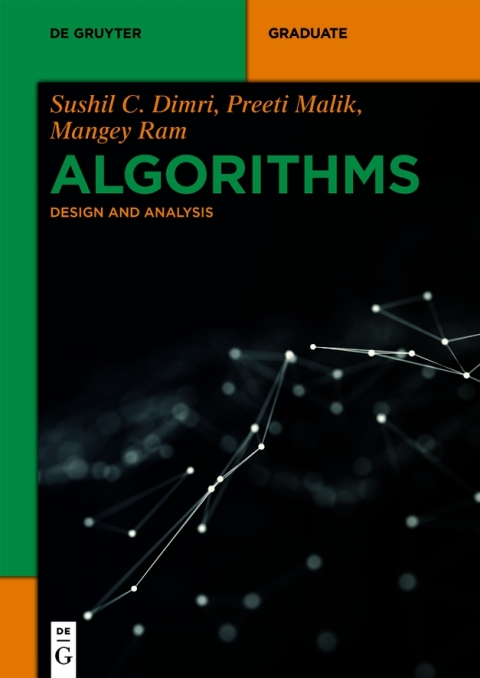Description
Efnisyfirlit
- Preface
- Chapter 1 Introduction
- 1.1 Algorithm
- 1.2 Another definition
- 1.3 Analyzing the performance of algorithms
- 1.4 Growth of the functions
- 1.5 Asymptotic notations
- 1.5.1 The O (big oh) notation
- 1.5.2 The Ω notation
- 1.5.3 The θ notation
- 1.6 Recurrence relation
- 1.6.1 Linear recurrence relation
- 1.6.2 Solution of homogeneous recurrence relation
- 1.6.3 Solution to nonhomogeneous linear recurrence relation
- 1.7 Divide and conquer relations
- 1.7.1 Solution to DAC recurrence relation
- 1.7.2 The recursion tree method
- 1.7.3 The substitution method
- 1.7.4 Change of variable method
- 1.8 Master’s theorem
- Problem set
- Chapter 2 Sorting techniques
- 2.1 Sorting
- 2.2 Insertion sort
- 2.2.1 Analysis of insertion sort
- 2.3 Quick sort
- 2.3.1 DAC approach
- 2.3.2 Analysis of quick sort
- 2.4 Merge sort
- 2.4.1 Analysis of merge sort
- 2.5 Heap sort
- 2.5.1 Analysis of Heapify
- 2.5.2 Heap sort
- 2.5.3 Analysis of heap sort
- 2.6 Sorting in linear time
- 2.7 Counting sort
- 2.7.1 Analysis of counting sort
- 2.8 Radix sort
- 2.8.1 Analysis of radix sort
- 2.9 Bucket sort
- 2.9.1 Analysis of bucket sort
- 2.9.2 Binomial distribution
- Problem set
- Chapter 3 Algorithm design techniques
- 3.1 Greedy approach
- 3.1.1 Traveling salesman problem
- 3.1.2 Fractional knapsack problem
- 3.2 Backtracking
- 3.2.1 Hamiltonian cycle
- 3.2.2 8-queen problem
- 3.3 Dynamic programming
- 3.3.1 0/1 knapsack problem
- 3.3.2 The traveling salesman problem
- 3.3.3 Chain matrix multiplication
- 3.3.4 Optimal binary search tree
- 3.4 Branch-and-bound technique
- 3.4.1 Assignment problem
- 3.4.2 Knapsack problem
- 3.5 Amortized analysis
- 3.5.1 Aggregate method
- 3.5.2 The potential method
- 3.6 Order statistics
- Problem set
- Chapter 4 Advanced graph algorithm
- 4.1 Introduction
- 4.1.1 Terminology
- 4.2 The graph search techniques
- 4.2.1 Breadth first search
- 4.2.2 Depth first search
- 4.3 Spanning tree
- 4.3.1 Kruskal’s algorithm
- 4.3.2 Prim’s algorithm
- 4.4 Shortest path algorithm
- 4.4.1 Warhsall’s algorithm
- 4.4.2 Floyd Warshall’s algorithm
- 4.4.3 Dijkstra algorithm
- 4.4.4 Bellman–Ford algorithm
- 4.5 Maximum flow
- 4.5.1 Maximum flow and minimum cut
- 4.5.2 Ford Fulkerson method
- Problem set
- Chapter 5 Number theory, classification of problems, and random algorithms
- 5.1 Division theorem
- 5.1.1 Common divisor and greatest common divisor
- 5.2 Chinese remainder theorem
- 5.3 Matrix operations
- 5.3.1 Strassen’s matrix multiplication
- 5.3.2 Divide and conquer for matrix multiplication
- 5.3.3 Strassen’s multiplication
- 5.4 Pattern matching
- 5.4.1 The Naive algorithm
- 5.4.2 The Rabin–Karp algorithm
- 5.5 P and NP class problem
- 5.5.1 Reducibility
- 5.5.2 NP complete problem
- 5.6 Approximation algorithms
- 5.6.1 Relative error
- 5.6.2 Approximation algorithm for TSP
- 5.6.3 The vertex cover problem
- 5.7 Deterministic and randomized algorithm
- 5.7.1 The nut and bolt problem
- 5.8 Computational geometry
- 5.9 The convex hull
- 5.9.1 Counterclockwise and clockwise
- 5.9.2 Finding whether two line segments intersect
- 5.10 Class P problems
- 5.10.1 NP (nondeterministic Polynomial Time) Problems
- 5.10.2 Any problem in P is also in NP
- 5.10.3 NP Hard Problems
- 5.10.4 NP Complete
- 5.10.5 Halting Problem for Deterministic Algorithms
- 5.10.6 The satisfiability problem
- 5.11 Clique
- 5.11.1 Clique Decision Problem
- 5.11.2 Non-Deterministic Algorithm for Clique Decision Algorithm
- Problem set
- Chapter 6 Tree and heaps
- 6.1 Red–Black Tree
- 6.2 Operations on RBT
- 6.2.1 Rotation
- 6.2.2 Insertion
- 6.2.3 Deletion
- 6.3 B-tree
- 6.3.1 Searching key k in B-tree
- 6.4 Binomial heap
- 6.4.1 Binomial heap
- 6.5 Fibonacci heap
- 6.5.1 Operation on Fibonacci heap
- Chapter 7 Lab session
- Appendices
- Further reading
- Index







Reviews
There are no reviews yet.